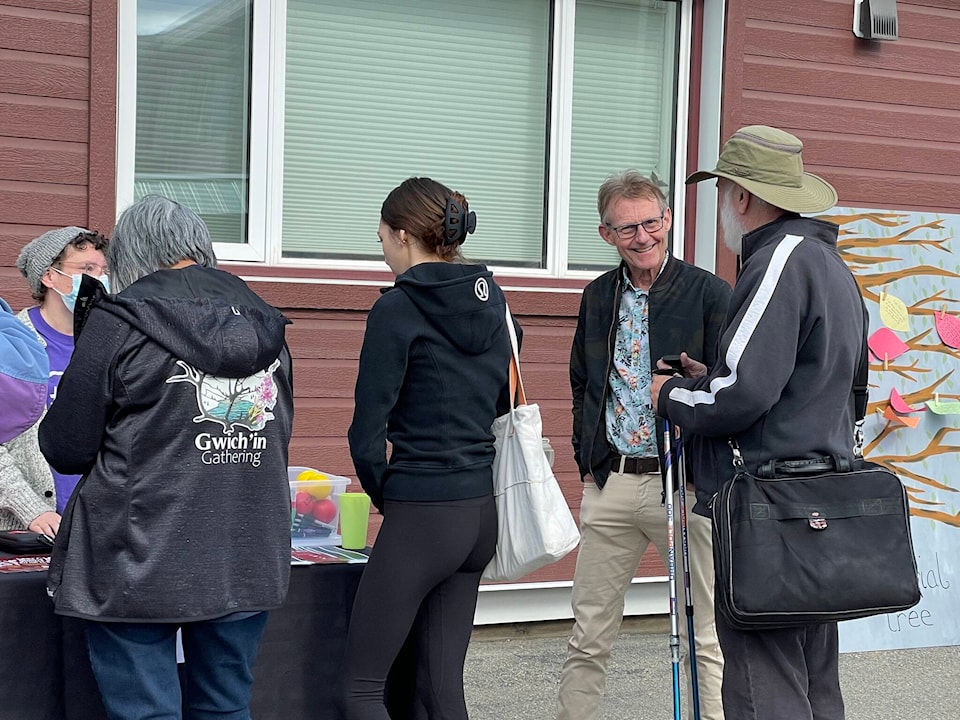International Overdose Awareness Day was recognized in communities across Canada on Aug. 30.
People gathered in quiet reflection in the parking lot of Blood Ties Four Directions to remember loved ones lost to overdose deaths in the Yukon. It was not a day of speeches; it was a day of quiet conversations and an opportunity to reflect upon what is needed to stop the deaths. Support staff from different organizations mingled with family members. A few politicians hung on the periphery. Everyone ate stew and bannock.
“Seventy-one individuals who are part of our community are no longer here today,” said Blood Ties executive director, Brontë Renwick-Shields. “We come together today to say that people who use drugs matter, and they are valued members of our community. And they deserve love, respect and dignity. They deserve health services that meet their needs. And they deserve action to prevent these preventable deaths.”
Concurrent events were held in Victoria, Kamloops, Vancouver, Ontario and beyond. Events were hosted by a diverse set of groups such as First Nations Health Authorities, Fraser Health, societies such as Mothers Stop the Harm, or different community action groups, along or in partnership with other agencies. They all called for increased mental health supports.
The News reached out to Dr. David Hammond, a professor and University Research Chair in Public Health in the School of Public Health Sciences at the University of Waterloo the same morning. He said that across Canada, we have a tragic situation where issues around mental health and substance use do not have the services and supports that are needed, and how that is even more of a problem in northern, remote communities.
Hammond reminded there is obviously an immediate need to reduce harm, but he also spoke about a broader set of risks and responses that are needed: “how can we not just reduce people dying from opioid use, but how we can reduce opioid use overall so that people aren’t subjected to the risks.”
As a researcher he says he is always looking for the information that will foster effective recommendations.
“I think first of all, we need to understand why people are using these substances. You need to reach these communities and treat them with respect and part of that means understanding why they’re using it and what their needs are … then, develop services and tailor them to meet community needs.”
He recognizes the need for mental supportive mental health strategies and services, but he says, “that is only a half-step to talking about issues of housing and things like that. There’s a huge part of this with all those things clustered together.” He is hopeful that the increase in the number of politicians talking about mental health and substance use will effect change.
Politicians voice words
Tracy-Anne McPhee, Yukon minister of health and social services, was present at the Aug. 30 gathering and issued a statement that afternoon.
“This journey represents a considerable challenge that requires us all to work together as local, territorial and federal governments, First Nations, community partners and Yukoners to respond immediately to public health needs and create stronger, more inclusive and healthier communities,” McPhee said.
A Recovery Day celebration is also planned nation-wide later this month.
Recovery Day was first observed on Sept. 30, 2012 in Vancouver. It was declared by an official proclamation from Mayor Gregor Robertson. The following year, a dozen cities throughout Canada hosted Recovery Day events. In 2015, close to 30 cities participated in Recovery Day and held events and activities.
Communities in action
Large-scale recovery day events will be held in Winnipeg, Calgary and Vancouver on Sept. 10.
The News spoke with Giuseppe Ganci, chair of the recovery day committee in Vancouver on Sept 1. Ganci told how a recovery movement has been created over the past 10 years. At first, there was nothing but reluctance because recovered people wanted to stay invisible.
“People talk about the stigma of addiction. The stigma of recovery is huge,” he said.
At first only a few people would gather, then it grew, as people gave up their siloed mindsets and biases, and realized there were many paths to recovery. And that their recovery was cause for celebration. Six years ago, the event was deemed too large for downtown Vancouver and moved to New Westminster where the city has embraced the recovery community.
Ganci parallels the growth of the recovery movement to being much like acceptance that grew for Pride events, with original reluctance to being embraced by not only the LGBTQ community, but their families, friends, allies and eventually, society at large.
“So the exact same things happened with Recovery Day. Ten years later, we have 200 vendors. We have people from all different pathways and all different walks of the community. We have sponsors, immediate sponsors, and we have lots of people — that possibly this year, we may get about 50,000 people, and it’s not just people in recovery.”
The line-up for this year’s Recovery Day street fest in New Westminster includes Tom Cochrane, Snotty Nose Rez kids, Busty and the Bass, Fred Penner and many more.
Across Canada, efforts to have September officially declared Recovery Month are underway. A petition can be found at recoverymonthcanada.ca. The declaration requires the involvement of members of parliament. The petition states the declaration is to recognize and support Canadians recovering from addiction and to demonstrate that recovery from addiction is possible, attainable, and sustainable.
Contact Lawrie Crawford at lawrie.crawford@yukon-news.com
